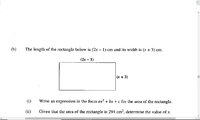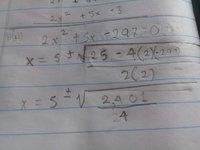You are using an out of date browser. It may not display this or other websites correctly.
You should upgrade or use an alternative browser.
You should upgrade or use an alternative browser.
Solving for x
- Thread starter Denzel
- Start date
Hi Denzel. Welcome to Free Math Help
Please read https://www.freemathhelp.com/forum/threads/guidelines-summary.109845/#post-422890
Please give the problem completely and exactly. A rectangle has two relevant lengths, height and width, not merely one.
If 2x - 1 and x + 3 are the width and height, then the area is expressed algebraically as WHAT?
Please read https://www.freemathhelp.com/forum/threads/guidelines-summary.109845/#post-422890
Please give the problem completely and exactly. A rectangle has two relevant lengths, height and width, not merely one.
If 2x - 1 and x + 3 are the width and height, then the area is expressed algebraically as WHAT?
Last edited:
The length of a rectangle is (2x -1) and width (x+3), given that the area is 294cm^2 , determine the value of x. I've attempted using
x=−b±√b2−4ac/2a, The answer is supposed to be x=11.
Attachments
2x^2 +5x-3Okay, so the area is the product of the width and the height:
[MATH]A(x)=(2x-1)(x+3)[/MATH]
Can you expand that to get this in the form required for part a) of the question?
- Joined
- Nov 24, 2012
- Messages
- 3,021
2x^2 +5x-3
Yes, so now equate this to 294, and then solve for \(x\):
[MATH]2x^2+5x-3=294[/MATH]
[MATH]2x^2+5x-297=0[/MATH]
Can you now factor?
Okay. I tried..I don't know if I'm going correct( if it's even the right way...) or how to continue.Yes, so now equate this to 294, and then solve for \(x\):
[MATH]2x^2+5x-3=294[/MATH]
[MATH]2x^2+5x-297=0[/MATH]
Can you now factor?
Attachments
- Joined
- Nov 24, 2012
- Messages
- 3,021
Okay, if you're using the quadratic formula, then you want:
[MATH]x=\frac{-5\pm\sqrt{2401}}{4}[/MATH]
Now, 2401 is a perfect square. We should be able to easily see that:
[MATH]50^2=2500[/MATH]
Hence:
[MATH]49^2=(50-1)^2=50^2-2\cdot50+1=2500-99=2401[/MATH]
And so, we would find (after discarding the negative root since it will lead to negative measures of length):
[MATH]x=\frac{-5+49}{4}=\,?[/MATH]
[MATH]x=\frac{-5\pm\sqrt{2401}}{4}[/MATH]
Now, 2401 is a perfect square. We should be able to easily see that:
[MATH]50^2=2500[/MATH]
Hence:
[MATH]49^2=(50-1)^2=50^2-2\cdot50+1=2500-99=2401[/MATH]
And so, we would find (after discarding the negative root since it will lead to negative measures of length):
[MATH]x=\frac{-5+49}{4}=\,?[/MATH]
x=11 THANK You. It always seems easy after I understand it... Then I ask, "Why did I not understand in the first place?"Okay, if you're using the quadratic formula, then you want:
[MATH]x=\frac{-5\pm\sqrt{2401}}{4}[/MATH]
Now, 2401 is a perfect square. We should be able to easily see that:
[MATH]50^2=2500[/MATH]
Hence:
[MATH]49^2=(50-1)^2=50^2-2\cdot50+1=2500-99=2401[/MATH]
And so, we would find (after discarding the negative root since it will lead to negative measures of length):
[MATH]x=\frac{-5+49}{4}=\,?[/MATH]
- Joined
- Nov 24, 2012
- Messages
- 3,021
Yes, let's try factoring:
[MATH]2x^2+5x-297=0[/MATH]
We want two factors of 2(-297)=-594 whose sum is 5, or equivalently, we want two factors of 594 whose difference is 5. We find:
[MATH]594=2\cdot3^3\cdot11=22\cdot27[/MATH]
These are the factors we want, and since 22 is divisible by 2, we then find:
[MATH]2x^2+5x-297=(2x+27)(x-11)=0[/MATH]
[MATH]2x^2+5x-297=0[/MATH]
We want two factors of 2(-297)=-594 whose sum is 5, or equivalently, we want two factors of 594 whose difference is 5. We find:
[MATH]594=2\cdot3^3\cdot11=22\cdot27[/MATH]
These are the factors we want, and since 22 is divisible by 2, we then find:
[MATH]2x^2+5x-297=(2x+27)(x-11)=0[/MATH]
Oh. I see the error, ( just fixed it ) but no, I had it as b^2 in my book, only made a typo on here, I just didn't understand. ^-^Please note that you listed the quadratic formula incorrectly. Maybe that is why you were getting the wrong answer. Do you see why your formula is wrong?
… using
x=−b±√b^2−4ac/2a, ...
You edited that thread post, but that formula, written out in horizontal style, is wrong in at least three places:
1) There are grouping symbols missing around the radicand.
2) There are grouping symbols missing around the denominator.
3) There are grouping symbols missing around the numerator.
Look at this:
x = [−b ± √(b^2 − 4ac)]/(2a)
Otis
Elite Member
- Joined
- Apr 22, 2015
- Messages
- 4,589
Adding to lookagain's comments: Yes -- without the grouping symbols, someone unfamiliar with the formula might read your typing as:-b±√b2−4ac/2a
\(\displaystyle -b \pm \sqrt{b^2} - \frac{4ac}{2a}\)
It takes time to learn how to type math expressions, using a keyboard, but the basic rule for radicals and ratios containing more than a single number/symbol is to enclose them in grouping symbols.
? In the forum guidelines, there's a link for Formatting Math as Text.
I'm more concerned about how you wrote the quadratic formula in your work. You need to divide everything by 4. You also wrote b instead of -b. That is, write:
\(\displaystyle \frac{-5 \pm \sqrt{2401}}{4} \quad \text{ instead of } \quad 5 \pm \frac{\sqrt{2401}}{4}\)
Cheers
?


